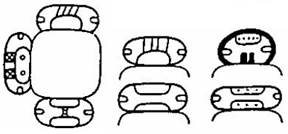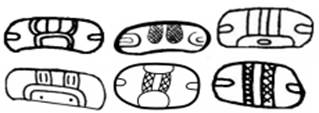![]()
![]()
![]()
![]()
![]()

K&H.p80.#8 TOK.p20.r4.c2 TOK.p7.r2.c3 TOK.p7.r2.c4 BMM9.p10.r1.c3 T109
CHAK CHAK CHAK CHAK CHAK

![]()
![]()
![]()
K&L.p33.#2 JM.p52.#2 JM.p52.#3 JM.p52.#4
CHAK CHAK CHAK CHAK



TOK.p20.r4.c4 = BMM9.p16.r5.c4 JM.p52.#5 JM.p53.#1
CHAK CHAK CHAK CHAK
· Variants (2):
o A. Abstract – features:
§ Flint outline.
§ Two small dots, one at each end, on the inside of the narrow end of the flint (diagnostic).
§ Two cross-hatched bands connecting the longer sides they connect the outer walls if the internal ovals are absent, or the inner sides of the internal ovals, if the latter are present.
§ Optional (but common) are one oval element on the inside of each of the two “long” sides, and even more optional are the 3 tiny non-touching dots inside each oval – the alternatives are:
· No ovals.
· Bottom oval only.
· Both bottom and top oval.
o B. Representational (mandible):
§ Jawbone itself.
§ 2 – 3 touching teeth, hanging from the upper surface.
§ This is an older form (lost reference).
· Contrasting with YAX: In the more reduced forms, CHAK can be confused with YAX. See YAX for more information.
· Do not confuse this with the phonetically similar ch’ak = “to chop” , “to axe” , “to decapitates”. “To chop/axe” has a glottalized ch’a- at the start while “red” has a plain cha- at the start. There is unlikely to be any confusion as there is no semantic or visual connection, but it is stated here for the sake of completeness.
· Do not confuse the abstract variant of CHAK with the abstract variant of BAAK. They are visually somewhat similar in that both can have an internal oval on each of the long sides, with three non-touching dots in the oval. The difference is that:
o CHAK has two parallel cross-hatched bands running through the middle of the glyph, connecting the two ovals. These bands run parallel to the short axis of CHAK, perpendicular to the axis of the wavy or dotted line of BAAK.
o BAAK has a wavy or dotted line running through the middle of the glyph, connecting the (larger) dot at one end to the (larger) dot at the other. This line runs along the long axis of BAAK, perpendicular to the axis of the two parallel cross-hatched bands of CHAK.
· Do not confuse the (abstract variant of) CHAK with the visually similar ko:
o They are both “ovalish” (rectangles with rounded corners), rotatable signs.
o They are both have a dot at each end of the glyph.
but:
o CHAK has two parallel cross-hatched bands running perpendicular to the long-axis of glyph (i.e., along the short axis of the glyph).
o ko has two parallel cross-hatched bands running along the long-axis of glyph.